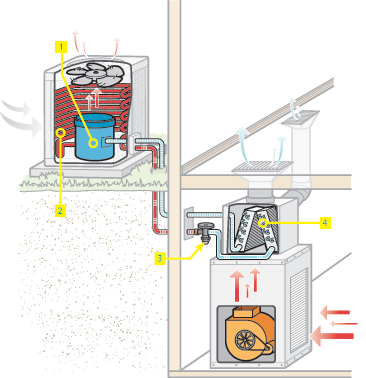
“An air conditioner works like your refrigerator,” says Scott Needham, president of Princeton Air in West Windsor.
 “It moves heat from one space to another.” According to the second law, when solids, liquids, or gases of different temperatures meet, heat shifts from the warmer to the cooler until they reach the same temperature, or equilibrium. People used to effect heat transfer, as it’s called, by blowing hot air across blocks of ice or towels soaked in ice water. It worked but required massive amounts of ice or cold water.
“It moves heat from one space to another.” According to the second law, when solids, liquids, or gases of different temperatures meet, heat shifts from the warmer to the cooler until they reach the same temperature, or equilibrium. People used to effect heat transfer, as it’s called, by blowing hot air across blocks of ice or towels soaked in ice water. It worked but required massive amounts of ice or cold water.
In July 1881, for example, when President James Garfield, shot by an assassin, lay dying in Elberon for over two months, doctors went through 250 tons of ice to cool his room.
Then, in 1906, New Yorker Willis H. Carrier patented an “Apparatus for Treating Air,” initiating the age of air conditioning. In 1915, Carrier formed the company that still bears his name. Early units were massive, costly, and—because they used toxic ammonia or sulfur dioxide as a refrigerant—dangerous. Then came Freon, which had environmental problems. Early forms of Freon have been replaced by green HFCs. Apart from that, modern air conditioning systems still work the way Carrier envisioned.
1) PUMP IT UP
The beating heart of any AC unit or system is the compressor, which pressurizes and pumps odorless, non-flammable refrigerant (hydrofluorocarbons, or HFCs, generically referred to as Freon) through a closed loop of copper pipe. Unlike earlier forms of CFC-based Freon, a DuPont trade name, HFCs don’t deplete the ozone layer and are far safer than ammonia, the substance used in the first AC systems.
2) Relativity
Pressurizing and pumping freon inevitably raises its temperature (to as much as 150 degrees F). To cool the vapor, the Freon is sent to the condenser, a barrel-like honeycomb that surrounds the compressor in its outdoor housing. Outside air, no matter how hot, is cool compared to the freon. As the vapor passes through capillaries in the condenser, it is cooled by outside air blowing through the condenser.
3) Spray This
Freon leaves the condenser at about 100 degrees F on its way to the expansion valve, located indoors. Within the valve, a spray nozzle disperses the vapor into a wider- diameter pipe. The infinitesimal droplets have a large surface area compared to their volume, facilitating cooling, as does the expanded pipe size. Freon, which boils at 38 degrees F, leaves the expansion valve as a 20-degree liquid.
4) Take the Heat
Last stop in the loop is the evaporator, which works like the condenser, but in reverse. Hot interior air is blown across coils of chilled freon. The freon absorbs the heat; moisture in the air condenses on the cold coils and drips into a drain. Result: cool, dehumidified air that can be blown through ductwork. The Freon, exiting the evaporator at about 50 degrees F, returns to the compressor, and the process begins anew.
